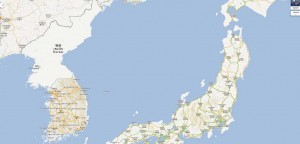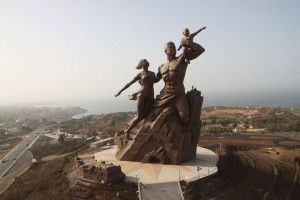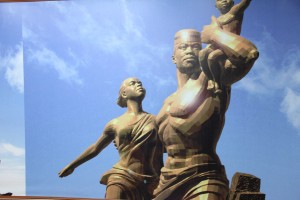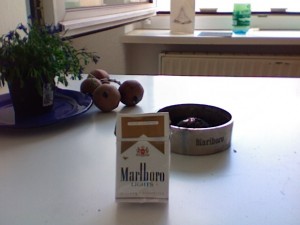Exported / Imported Identity
Globalization, compounded by the liberation of communication media, has arguably fed the cultural whitewashing of late capitalist homogenization – where the commodity of the sign and image consumption reign over the production force of locality. North Korea is a territory emancipated from this connectivity, a modern example of total representational and economic suppression of a whole body politic. At the same time that economic sanctions make it difficult for North Korea internationally, its most prominent art institution Mansudae Art Studio contributes a strange form of revenue in the form of exported commemoration Monuments. Strangely, but perhaps not surprising in the loose ethics of art market(s), an Italian representative company sells what is called “official North Korean art: (1), so artistic production is a useful form of autonomous revenue to the North Korean regime. The construction company Mansudae Overseas Project has built ‘cheap’ monuments in Botswana, Benin, Namibia, The Democratic Republic of Congo and Senegal. The Monument to African Renaissance (MAR) in Dakar, Senegal is by all means the largest and most controversial, and is the subject of this text. The MAR is an imported monument, an outsourcing of psyche, artistic and physical labor. If representational identity is not created from within a society, but is imposed on it, is the representation produced merely a result of capital agendas, and the destructive forces of global trade and image production? Is MAR not a monument of these toxic, stifling production systems, as opposed to its caption African Renaissance?
The MAR depicts an African family, a family essentially built and exported from North Korea. The monument was built at a huge cost, officially it cost 26 million USD, but some say it could have cost three times this figure. Politician Abdoulaye Wade, who was President of Senegal from 2000 to 2012, commissioned the Monument to African Renaissance. Wade used state owned land in Dakar to pay North Korea, so the MAR has some family roots – if only at the level of topographical capital for production. Wade intended the monument to represent “Africa emerging from darkness, from five centuries of slavery and two centuries of colonialism (2).” But surely the outsourcing of such a national representation of Africa, of her intellectual and manual labor —— an outsourced depiction of an African Family — merely supplants the social and existential consequences of colonization with the aesthetic, ethical and fiscal impositions of global production. This is not hidden information. This text is not an expose, the MAR as an institution is extremely transparent in admitting the North Korean genealogy of African Renaissance. The communist, North Korean aesthetic of the monument make it appear dislodged, almost digital and out of place in Dakar’s landscape. Furthermore the depiction of the mother figure with very little clothes on has offended the Muslim community of Dakar, who make up the majority of the population. The structural problems and poverty in the city of Dakar make the MAR an extremely disgraceful, and frankly infuriating waste of money. An example of empty, hollow representation, concealing other agenda’s — that is if representation such as this could ever be anything more than the sealed surface of agenda.
“[…] with respect to apparently peaceful times: what a grotesque error to think that the unconscious-as-child is acquainted only with daddy-mommy, and that it does not know “in its own way” that its father has a boss who is not a fathers father, or moreover that its father himself is a boss who is not a father” Deleuze and Guattari, Anti-Oedipus. (3)
In Anti-Oedipus: Capitalism and Schizophrenia, Deleuze and Guattari align the psychic repression of Oedipalisation with the “same history of capital”(4). The MAR father figure is sweeping up the mother figure; he is the artifice of an internal building that will be discussed below. The father is holding up an infant, presumably toward better futures for Africa. The Oedipal loop of the MAR and the North Korean capitalization of foreign representation, is an almost painfully obvious connection to Deleuze and Guattari’s discourse around the existential impositions of psychic repression and forms of production. Also, the issue of ownership is not so much on the idea of possession, but on the ideological and economic systems behind the Oedipal triangle. Representation plays an extremely important, if sometimes concealed, role in the suppression Deleuze and Guattari contemplate. The politics of the MAR’s production seems to ignore real African production. It is completely separated from the ideal of African Productivity in the forms of representation, labor, infrastructure and liberation, ironically via the representation of a family unit. In a way it is no so far from “the pseudo triangle, [where] mommy was dancing with the missionary, daddy was being fucked by the tax collector, while the self was being beaten by a white man” (5)
The MAR is located nearer to the Airport than to the streets of Dakar, and we mostly saw it in the horizon. This distance of viewing in itself is aligned with how distant the monument is from the needs and entitlements of the people of Dakar. On the 15 min taxi drive to the monument I also realized that we were going to see a ‘left over’ project by former president Abdoulaye Wade (an extremely arrogant, dictator in magnitude project at that). Many of the population of the reject the monument and its claim toward Renaissance — it is called “Wades monument by some”. I was struck by the poltical agency and ownership claimed by Dakars population during Wades recent election scandal. Claimed at many points to be ‘taller than the statue of liberty’, we also heard that Wade stole the MAR design from a well known Senegalese artist — of course there is no way to verify this. But the Statue of Liberty was built in France, and now it is the symbol of America par excellence, and its particular brand of ‘liberty’ — a land that is certainly not mapped in units of economic freedom either.

A VIP room in the internal building of the Monument to African Renaissance, interior designed by Wades wife, and with traditional Artworks from the African Continent on the walls.
The central father figure actually forms the artifice of an internal building, with nothing more than irrelevant corporate space, questionable historic information, and a VIP room, interior designed by Wades wife. There is an elevator to the head of the man, where visitors can take in the view around the monument, and even be pointed toward the land used as payment. Most disturbing of all is Wade has claimed intellectual property and gets 33% of any revenue created. We had a guided tour by a man who was also a comedian; he answered all questions concerning the North Korean involvement. Obviously a Wade supporter, he claimed that a lot of people love the monument. When asked about the ethical factors, and the great contrast between the poverty of the city and the decadence of the monument, he replied: “All the big countries in the world, if you go to any country, if you’ve got a big project, normally a lot of people are not comfortable with the big projects, it is always happening like this.” (6)
Big projects indeed, a big art project essentially authored by one man. Suggesting as Hal Foster does that a ‘stock broker could assume the mantle of Duchamp, and an investment banker could cite institutional critique as his formative influence’ (7). At the foot of the monument we were shown a military compound where two North Koreans live, they are in charge of maintenance. Obviously, they were not available for coffee. The monument is an infuriating thing ‘in-and-of-itself’, considering the poverty that surrounds it. As was mentioned earlier, this level of transparency concerning the monuments production, paradoxes and outsourcing creates another set of questions concerning the role of critique. As I look at the empty packet of contraband Marlboro Lights I bought for €1 in Dakar, I imagine the MAR to be a perfect target for a contemporary movement of iconoclasts. But in many ways, I am trying to grasp the point of critique – if capitalism in itself appropriates and re-capitulates forms of critique to its own strange development. The MAR almost destroys its own intentions Vis-a-Vis the politics and paradox of its own production. In true Oedipal and capitalist fashion, it is as if the MAR desires its own destruction — or desired its own repression.
(1) http://www.mansudaeartstudio.com/
(2) http://artasiapacific.com/Magazine/72/HollowMonuments
(3) Deleuze and Guattari, Anti-Oedipus: Capitalism and Schizophrenia, Continuum, 2007.
(4) Ibid 3
(5) Ibid 3
(6) Tour guide at Monument to African Renaissance (from video footage)
(7) Hal Foster, Return of the Real, MIT Press, Cambridge.



